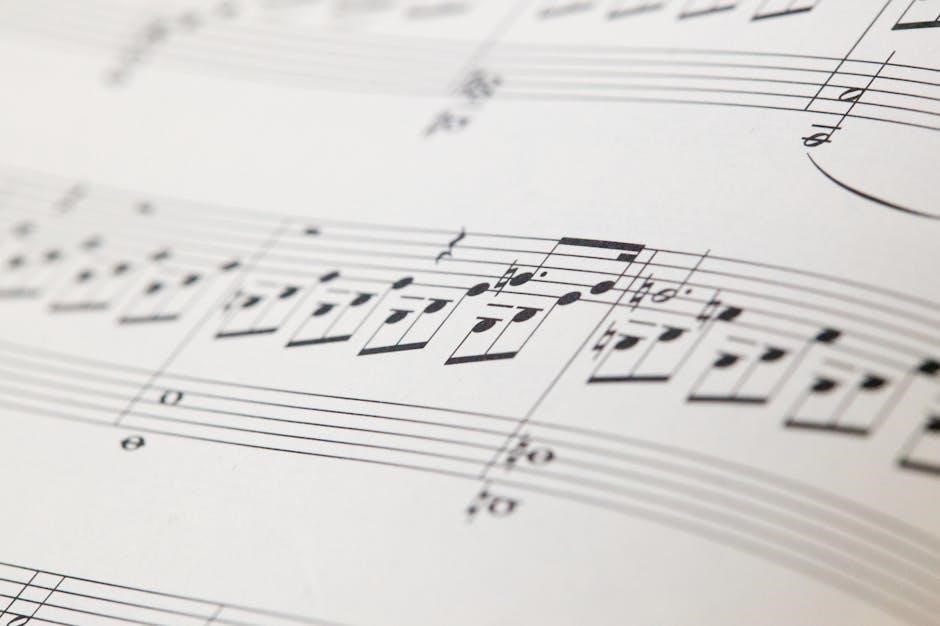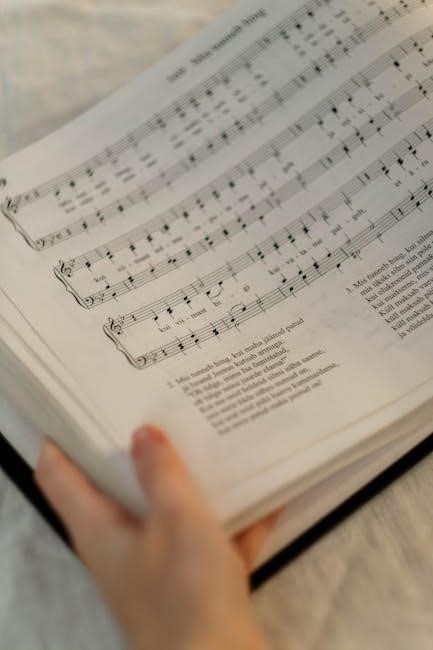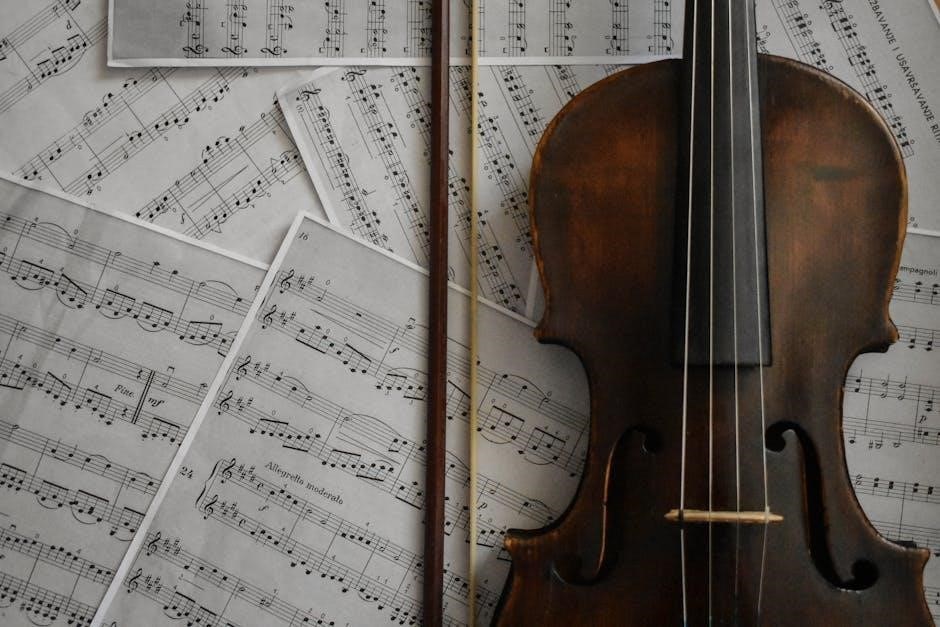Understanding the Bass Clef
The bass clef, also known as the F-clef, is a musical symbol used to indicate the pitch of written notes. It helps in reading the lower registers of music, particularly those played by instruments like the bass guitar, cello, and the left hand on the piano.
What is the Bass Clef?
The bass clef, often referred to as the F clef, is a fundamental symbol in musical notation. Its primary function is to indicate the pitch of notes written on the staff, specifically for lower-pitched instruments and voices. The clef itself is drawn starting from the fourth line of the staff, with the two dots positioned above and below this line, signifying that the F note is located on that line. This contrasts with the treble clef, which focuses on higher pitches. Understanding the bass clef is crucial for pianists, bass players, and other musicians who deal with lower-range musical parts. It is a vital skill for any musician to master, as it unlocks a vast repertoire of musical possibilities and facilitates a deeper understanding of harmony and musical structure.

Reading Bass Clef Notes
Reading bass clef notes involves understanding the staff, lines, and spaces. Each line and space corresponds to a specific note, enabling musicians to interpret and play written music accurately, usually for lower-pitched instruments.
Bass Clef Staff: Lines and Spaces
The bass clef staff consists of five lines and four spaces, each representing a different musical note. Notes can also appear above or below the staff using ledger lines. The lines, from bottom to top, represent the notes G, B, D, F, and A. A helpful mnemonic for remembering these lines is “Good Boys Do Fine Always.” The spaces, from bottom to top, represent the notes A, C, E, and G. These can be remembered with the mnemonic “All Cows Eat Grass.” Understanding the placement of notes on the lines and spaces is crucial for reading music written in the bass clef. This knowledge facilitates accurate and confident performance.
Guide Notes in the Bass Clef
Guide notes are reference points on the bass clef staff that help quickly identify other notes. Two common guide notes are F and C. The bass clef symbol itself indicates the F line, as the two dots surround it. Knowing F, you can easily determine neighboring notes. Similarly, middle C is located one ledger line above the bass clef staff. Using these guide notes, one can navigate the staff by counting up or down. For instance, a note one step below C is B, and a note two steps above F is A. This technique simplifies note reading, particularly for beginners, by providing familiar anchors on the staff.
Mnemonics for Bass Clef Notes
Mnemonics are memory aids that can assist in learning the notes on the bass clef staff. These phrases use the first letter of each word to represent the notes, making memorization easier and more efficient for beginners.
Line Notes Mnemonic
To easily remember the notes on the lines of the bass clef staff, a common mnemonic is “Good Boys Do Fine Always”. Starting from the bottom line and moving upwards, the notes are G, B, D, F, and A. This phrase provides a simple way to associate each line with its corresponding note.
Memorizing this mnemonic can greatly speed up the process of reading bass clef music. By quickly recalling the phrase, musicians can instantly identify the notes on the lines, leading to smoother and more accurate performances. Using “Good Boys Do Fine Always” serves as a valuable tool for mastering bass clef notation.
Space Notes Mnemonic
Remembering the notes in the spaces of the bass clef is made easier with the mnemonic “All Cows Eat Grass”. This corresponds to the notes A, C, E, and G, starting from the bottom space and moving upwards. This simple phrase provides a quick and effective way to recall the notes found within the spaces of the bass clef staff.
By associating each space with its corresponding note through this memorable phrase, musicians can improve their note-reading skills. Utilizing the “All Cows Eat Grass” mnemonic can enhance the ability to quickly identify notes, leading to more confident and accurate musical performances.
The Bass Clef and the Piano
The bass clef is essential for piano players, representing the lower notes typically played with the left hand. Understanding it unlocks the ability to read and play a wider range of piano music effectively.
Bass Clef Notes on the Piano Keyboard
Connecting the bass clef to the piano keyboard is crucial for pianists. The bass clef primarily represents notes played by the left hand, residing in the lower register of the piano. Locating notes on the staff and then finding their corresponding keys on the keyboard is essential.
Guide notes like bass C and bass F can be particularly helpful when learning to navigate the bass clef on the piano. These notes serve as reference points, allowing one to determine the position of other notes relative to them.
Understanding the spatial relationship between notes on the bass clef staff and the piano keyboard will greatly improve your playing confidence and musicality. Visual aids such as charts can be used to effectively learn bass clef notes on the piano.
Relationship to the Treble Clef
The bass clef and treble clef work together to represent the full range of musical notes, particularly on instruments like the piano. While the bass clef covers lower notes, typically played by the left hand, the treble clef represents higher notes played by the right hand.
Notably, middle C serves as a point of symmetry between the two clefs. It exists as the first ledger line above the bass clef and the first ledger line below the treble clef. Understanding this connection is crucial for reading music on the grand staff, which combines both clefs.
Also, each note in the bass clef is one full step below its corresponding note in the treble clef. Recognizing the relationship will help to quickly learn and read music in both clefs, and to understand piano sheet music.

Using Bass Clef Charts
Bass clef charts are valuable tools for learning and mastering the bass clef. These charts visually display the notes, their positions on the staff, and often their corresponding locations on a musical instrument.
Benefits of Using Charts
Using bass clef charts offers several advantages for musicians of all levels. Firstly, they provide a clear and concise visual representation of the notes on the bass clef staff, making it easier to identify and memorize them. Charts act as quick reference guides, enabling faster note recognition during practice and performance. They are particularly helpful for beginners who are just starting to learn the bass clef, as well as for experienced musicians who need a refresher.
Furthermore, charts can illustrate the relationship between the staff and the instrument’s fretboard or keyboard, facilitating a deeper understanding of music theory and improving overall musicianship. The detailed layout of lines and spaces on a chart aids in visualizing the spatial relationships between notes, fostering a more intuitive grasp of musical notation. By providing a readily accessible visual aid, bass clef charts contribute significantly to efficient and effective music learning.
Free PDF Charts for Bass Clef Notes
Numerous free PDF charts are available online to assist in learning bass clef notes. These charts offer a convenient and accessible resource for musicians of all levels. Often, these charts are designed with clear and easy-to-read layouts, featuring detailed diagrams of the bass clef lines and spaces. They can be easily downloaded and printed, making them ideal for practicing at home or on the go.
Many free PDF charts also include additional helpful information, such as mnemonics for remembering the notes and visual representations of the notes on a piano keyboard or bass fretboard. Some charts even offer interactive elements or links to online quizzes and resources. By utilizing these free PDF charts, learners can enhance their understanding of the bass clef and accelerate their musical progress.

Bass Clef and the Bass Fretboard
Understanding the relationship between the bass clef and the bass fretboard is crucial for bass players. Recognizing how notes on the staff translate to specific fretboard positions unlocks reading capabilities and improves musical fluency.
Connecting the Staff to the Fretboard
To effectively connect the bass clef staff to the fretboard, it’s essential to understand how each line and space corresponds to a specific note. This involves memorizing the notes on the staff, such as G, B, D, F, and A on the lines, and A, C, E, and G in the spaces. Recognizing guide notes like bass C and F can help you quickly identify other notes around them.
Once you know the notes on the staff, the next step is to translate them to the fretboard. Remembering that multiple locations can play same note is also important. Using a fretboard chart can be invaluable in this process.

Practical Application and Practice
Mastering the bass clef requires consistent practice. Utilize reading exercises, worksheets, and online resources to reinforce your knowledge. Apply what you learn to real music and bass fretboard for improvement.
Reading Exercises and Worksheets
To solidify your understanding of bass clef notes, incorporate regular practice using targeted reading exercises and worksheets. These resources provide a structured approach to note recognition, allowing you to gradually improve your sight-reading skills; Focus on identifying notes quickly and accurately. Many free, printable worksheets are available online, offering a variety of exercises suitable for different skill levels; Start with simple exercises and gradually increase the complexity as you progress. Consistent practice with these tools will build confidence and fluency in reading bass clef notation, ultimately enhancing your musical abilities. These exercises will help you to read bass clef notes for piano.
Online Resources and Quizzes
Explore the vast array of online resources and quizzes designed to reinforce your knowledge of bass clef notes. Numerous websites and apps offer interactive exercises, flashcards, and quizzes that make learning fun and engaging. These platforms provide immediate feedback, allowing you to track your progress and identify areas where you need more practice. Look for resources that offer customizable exercises, allowing you to focus on specific notes or ranges. Online quizzes can be a great way to test your recall and improve your speed and accuracy. Utilize these online tools regularly to supplement your practice and accelerate your learning journey. Music Tech Teacher has quizzes, games, and other resources.
